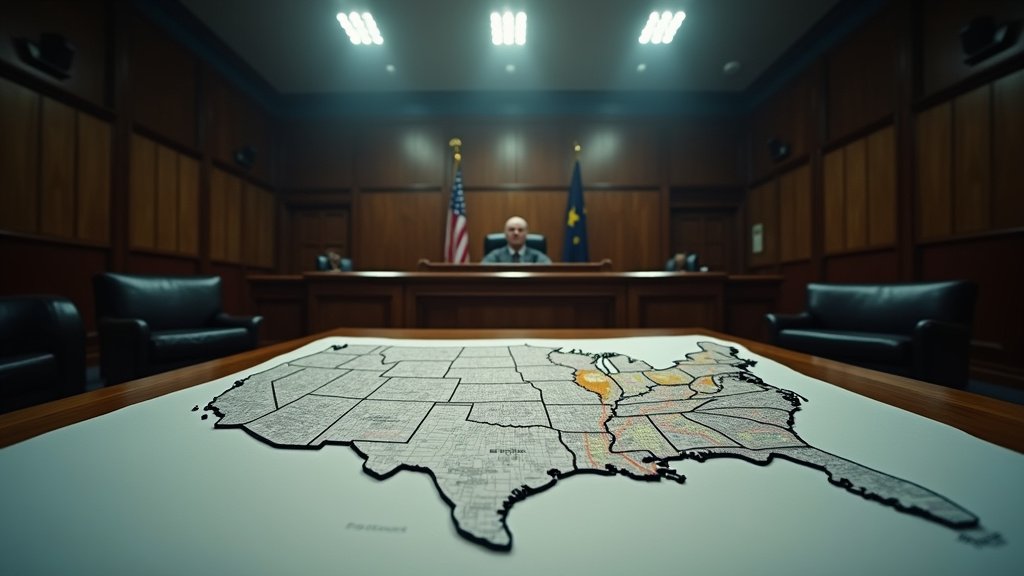El Paso, TX – A high-stakes federal trial is underway in El Paso, Texas, scrutinizing the state’s controversial mid-decade congressional redistricting maps. The lawsuit, brought forth by a coalition of civil rights groups including LULAC, the NAACP, and MALDEF, alleges that the Republican-drawn maps intentionally dilute the voting power of Black and Latino communities, violating federal law. At the heart of the case lies a critical legal question: were the new district lines drawn primarily based on race, which is unconstitutional, or on permissible political considerations?
The redistricting process, initiated by Governor Greg Abbott and unusual for occurring mid-decade rather than after the decennial census, is expected to create a net gain of five Republican congressional seats for Texas. This move has intensified political tensions and drawn national attention, with critics arguing that the maps were crafted to consolidate GOP power at the expense of minority representation.
The Core of the Challenge: Race vs. Politics
Plaintiffs contend that Texas legislative leaders engaged in racial gerrymandering, employing tactics such as “packing” and “cracking” to diminish the influence of minority voters. Packing involves concentrating voters of a particular demographic into a single district to reduce their voting power in surrounding districts, while cracking disperses them across multiple districts where they are outnumbered. This strategy, they argue, is evident in the redrawing of North Texas districts, specifically Congressional Districts 32 and 33. These changes are accused of consolidating minority voters into the 33rd District while weakening their strength in the 32nd. This reshaping effectively displaced Black Congressman Marc Veasey and concentrated Black voters further into Congresswoman Jasmine Crockett’s 30th District.
While Texas officials maintain that the maps were drawn with purely political motivations, a distinction that the Supreme Court has historically deemed legal, civil rights advocates argue that the effects of these political decisions are undeniably racial. They assert that gerrymandering for partisan gain inevitably and disproportionately harms minority voters, particularly Black voters who tend to vote for Democratic candidates.
Historical Context and Legal Precedents
This is not the first time Texas has faced federal challenges over its redistricting plans. The state has been found to have discriminated against Black and Brown citizens after previous redistricting cycles since the Voting Rights Act was enacted. The U.S. Supreme Court has previously ruled against Texas for racial gerrymandering, notably in Abbott v. Perez (2018) and League of United Latin American Citizens v. Perry (2006), where the court found that Texas weakened Latino voting strength.
Plaintiffs are specifically bringing claims under Section 2 of the Voting Rights Act, which prohibits voting practices that discriminate based on race, color, or membership in a language minority group. They also assert violations of the 14th Amendment’s Equal Protection Clause.
Arguments and Evidence Presented
During the trial, expert testimony has been crucial. Political science professor Matt Barreto testified that the map was a statistical outlier, suggesting it would be impossible to draw such a Republican-advantageous map without intentionally manipulating district lines to hit racial targets. Lawyers for the challengers have pointed to statements from Governor Abbott, who acknowledged “constitutional concerns” raised by the U.S. Department of Justice regarding race-based gerrymandering. While Texas attorneys have attempted to distance the state from the DOJ’s initial rationale, citing it as a “mistake” or “political cover,” plaintiffs view these statements as admissions that race played a role.
Conversely, state attorneys are emphasizing that the map was created “using political data from start to finish” and that racial demographics were not a primary consideration. Adam Kincaid, who is credited with drawing many of the state’s congressional boundaries, testified that he focused solely on political data and that the map was designed to maximize Republican electoral wins. However, Kincaid also described how he “completely transformed” districts like Texas’s 32nd, consolidating Democratic voters and creating a “mega-district” that packed minority voters into others.
Stakes for Representation and Political Power
The outcome of the El Paso trial carries significant weight. It will determine whether Texas can implement its new congressional map for future elections, potentially impacting the balance of power in the U.S. House of Representatives. Furthermore, the ruling could set precedents for how courts handle the complex interplay between partisan advantage and racial discrimination in redistricting. Civil rights advocates stress that while Texas is a rapidly diversifying state, its current and proposed maps fail to reflect this demographic shift, with white voters controlling a disproportionately high percentage of congressional seats compared to their share of the population. The news surrounding this legal battle highlights the ongoing struggle for equitable representation in Texas and across the nation.
Legal experts note that proving discriminatory intent can be challenging, as gerrymandering for political gain can have devastating effects on minority voting power, even if race is not explicitly cited as the sole motivation. The court’s decision in this contentious case will be closely watched, as it addresses fundamental questions of fairness and equal protection in the electoral process.






